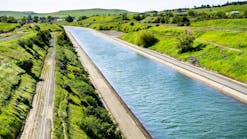About the author:
Keystone Retaining Wall Systems
www.keystonewalls.com | 800.747.8971
Retaining walls often are the structures of choice for many types of land and water control, as well as manipulation. They are a means to obtain or maintain dominance over the natural environment. Walls using mechanically stabilized earth (MSE) backfill are one type that may play an important role in addressing both soil erosion of river and stream banks, as well as flooding mitigation.
MSE wall advantages include substantially fewer construction costs than conventional walls and a range of aesthetic and design options. For these reasons, it became a key aspect of the multi-phase Master Development Plan for an eastern U.S. town that often was underwater.
Several years ago, LDA Eng., a Tennessee firm specializing in public infrastructure, was hired to address severe flooding in downtown Johnson City in eastern Tennessee. For decades, its historic downtown district suffered near-constant flooding at the intersection of two large streams. The flooding was a plague to area property owners and thwarted new business ventures.
A 16-sq-mile watershed drained into the creeks. In past decades, flooding was addressed with culverts built to transfer the creeks underground. Eventually, larger culverts were needed, until these did not have enough capacity to convey the water from heavy storm events. The city’s storm water manager felt that the old system would not handle a five-year storm, but the reality was that Johnson City was prone to flooding even without severe weather.
In 2007, a downtown task force was formed, which ultimately chose LDA to serve as its technical staff to help with meetings and provide engineering consulting, analysis and design for flood mitigation measures. Certain measures were approved and incorporated into a multi-phase Master Development Plan for the city.
Approved in 2012, the first of the priority projects in the plan was to redevelop the downtown land adjacent to Brush Creek into a park, an approach that would simultaneously implement flood mitigation measures and create an attractive and sustainable public green space. It was the initial step in a master plan that had a long-term goal of sparking redevelopment and making it possible for downtown Johnson City to realize its full economic and cultural potential.
The park project removed 700 ft of the underground Brush Creek triple barrel box culvert running beneath an old warehouse. It built an environmentally enhanced channel and constructed the five-acre greenway park along the creek banks which features a 200-seat amphitheater.
Keystone’s Country Manor retaining wall system was specified by LDA for the tiered channel walls. One of the most important considerations in selecting the wall system was its ability to withstand significant water flows and rapid drawdown of water from urban streams. The creek walls, which extend for long stretches on both sides of the creek as it runs through the downtown area, would be completely submerged during major rain events. Country Manor is rated for this type of water application; it also has broad design flexibility and face aesthetics that work well for coordinating the hardscape elements of an urban park.
The channel wall design was a stepped wall configuration that provides stream access during low flow times and stability during high flow events. The maximum wall height is 10 ft, with the longest wall at 933 ft and a total wall length for the project at 2,278 ln ft. The total wall area on the project is 12,415 sq ft.
The original bedrock on the project site was suitable for concrete leveling pads for the stepped retaining walls. To enhance and coordinate the park’s landscape scheme, Country Manor wall also was used to construct seat walls for the amphitheater.






